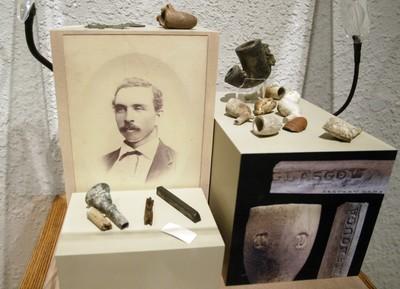Saloons and Spittoons

Saloons in the old west were more than just places to hoist a few alcoholic beverages.
In the case of a small town such as Virginia City, they often were the center of the social hub, with food, gambling and entertainment.
That’s what an archaeological exploration of four sites in Virginia City uncovered, and the results are on display in “Havens in a Heartless World: Virginia City Saloons and the Archaeology of the Wild West,” an exhibit at the Nevada State Museum & Historical Park.
Conducted from 1993 to 2001, the project excavated four saloons: the Boston Saloon, owned by a black man named William Brown; Piper’s Old Corner Bar, a theater saloon; the Hibernia Brewery and Saloon; and the O’Brien and Costello’s Shooting Gallery and Saloon, an Irish-American bar.
At the entrance to the exhibit are two doors taken from the Old Corner Bar, a saloon that was a favorite of Samuel Clemens, known by his pen name of Mark Twain. It is now a bookstore.
While Clemens and others maintained that his pseudonym came from a riverboat term for the depth of the water in the treacherous Mississippi River, other researchers claim it came from Clemens’ running bar tab at Piper’s saloon.
Whatever the case, Clemens was working as a reporter at the Territorial Enterprise when the city was crawling with miners seeking a fortune in the Comstock silver and gold boom from 1860 to 1880.
And the saloons were there to serve them. Each saloon served a different clientele. The best food was at the Boston Saloon because, as the excavation showed, it had the best cuts of meat. At O’Brien and Costello’s, customers could shoot a .22-caliber revolver for target practice.
The exhibit features many unique items. Heading the list is the Tabasco sauce bottle, which is believed to be the oldest known Tabasco bottle, dating from 1870 and excavated from the Boston Saloon.
There’s also an oversized spittoon from Piper’s bar, a cherry toothpaste container from the Boston Saloon, soda bottles from San Francisco and Honolulu, and what’s billed as the $16,000 bottle that contained Dr. Wonson’s Indian Root Bitters. The completely intact bottle was taken from Piper’s excavation site by a worker and sold for $16,000 in 1999. The thief went to jail.
One of the exhibit’s most unusual items is the carbon water filter from Fleet Street in London. It was used at Piper’s to create potable water.
The exhibit “shows Virginia City was a big city satisfying all kinds of people,” says Barbara Slivac, the museum’s curator of education.